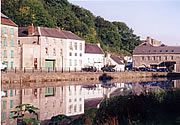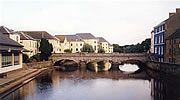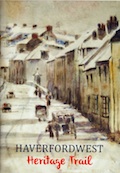Commerce and Industry

The Flemish immigrants, who figured prominently in the early history of Haverfordwest (more correctly Haverford), would have brought with them a knowledge of wool and of weaving. Moreover agriculture in the area was dominated by sheep farming. Not surprisingly, the town became a centre of textile manufacture. Giraldus, in the 12th century, refers to Haverford cloth. Leather was another industry of the infant borough.
But Haverford was above all a trading town. The right to hold fairs and markets was in the gift of feudal lords, whose charters conferred many such privileges upon the town. Producers had to come to Haverford to sell their produce. The same monopoly rights applied to movement of goods by sea. Shipments of wool or cloth or hides to, say, Bristol, had to leave from Haverford. The port was also a principal point of departure for Ireland, and staging post for pilgrims to St Davids - before the Black Death impeded all activity.

See: Haverfordwest Town Centre Partnership
The town was still recovering in 1474, when it was incorporated by a Royal Charter which conferred a degree of autonomy in the running of its affairs. It was granted a mayor, sheriff, bailiffs and common council, and the status of a county.
In the late medieval period there were other commodities to be handled: wines from France in addition to apples from England (for sale in one of the markets around St Mary’s church). Then and in subsequent centuries maintenance of the quay was a constant concern of the mayor, who is still, officially, ‘Admiral of the Port’. More quays were constructed which continued to support the local economy until the railway reached Haverfordwest in 1853. The port then went into rapid decline, although it remained in use into the 20th century.
Like every country town, Haverfordwest could mill its grain and make its own shoes. But in the 19th century it had its own industrial revolution. Close to the municipal boundary was the biggest cotton mill in Wales. Prendergast Mill was later converted and became one of several paper mills in the town (it now lies derelict). To the rear of Bridge Street an iron foundry was established. It prospered for a period and was almost certainly responsible for the decorative railings to be found fronting many buildings in the town. The only manufacturing enterprise to survive well into the 20th century was a specialist producer of churns and related butter-making appliances.
Today Haverfordwest is again almost entirely dependent on selling things, and the merchandise arrives neither by river nor by rail, but by road.

